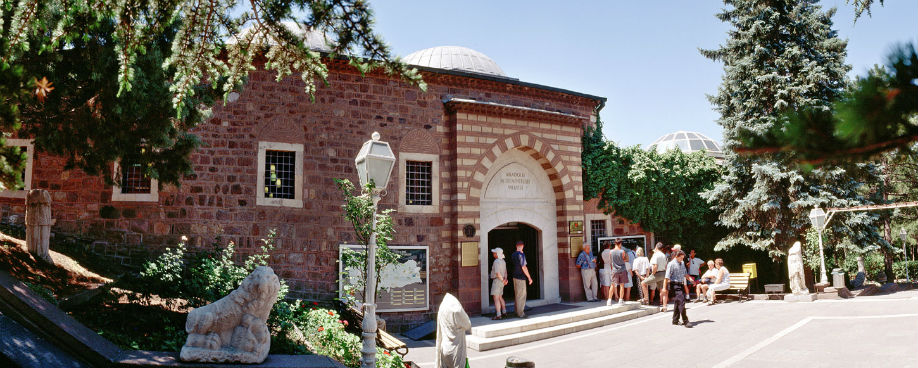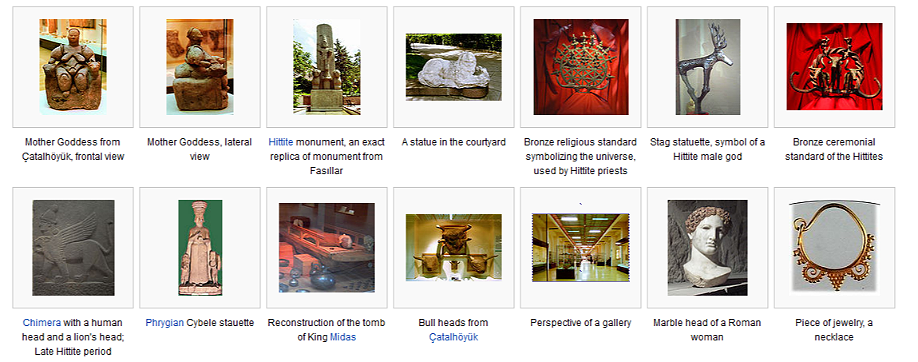The superb Museum of Anatolian Civilisations is the perfect introduction to the complex weave of Turkey’s ancient past, housing artefacts cherry-picked from just about every significant archaeological site in Anatolia.
The museum is housed in a beautifully restored 15th-century bedesten (covered market). The 10-domed central marketplace houses reliefs and statues, while the surrounding hall displays exhibits from the earlier Anatolian civilisations: Palaeolithic, Neolithic, Chalcolithic, Bronze Age, Assyrian, Hittite, Phrygian, Urartian and Lydian. The downstairs sections hold classical Greek and Roman artefacts and a display on Ankara’s history. Get there early to avoid the flood of tour groups and school parties.
The exhibits are chronologically arranged in a spiral: start at the Palaeolithic and Neolithic displays in the room to the right of the entrance, then continue in an anticlockwise direction, visiting the central room last.
Items from one of the most important Neolithic sites in the world Çatalhöyük, southeast of Konya – are displayed here. There’s a mock-up of the inside of a dwelling typical of those uncovered at the site, one of the most famous mother goddess sculptures unearthed from the excavations and wall paintings of hunting scenes.
Also on show are many finds from the Assyrian trading colony Kültepe, one of the world’s oldest and wealthiest bazaars. These include baked-clay tablets found at the site, which dates to the beginning of the 2nd millenium BC.
One of the striking Hittite figures of bulls and stags in the next room used to be the emblem of Ankara. The Hittites were known for their relief work, and some mighty slabs representing the best pieces found in the country, generally from around Hattuşa, are on display in the museum’s central room.
Most of the finds from the Phrygian capital Gordion, including incredible inlaid wooden furniture, are on display in the museum’s last rooms. The exhibits also include limestone blocks with still-indecipherable inscriptions resembling the Greek alphabet, and lion- and ram-head ritual vessels that show the high quality of Phrygian metalwork.
Urartian artifacts are also on display here. Spurred by rich metal deposits, the Urartians were Anatolia’s foremost metalworkers, as the knives, horse-bit, votive plates and shields on display demonstrate. There are also terracotta figures of gods in human form, some revealing their divine powers by growing scorpion tails, and neo-Hittite artefacts.
Downstairs, classical-period finds and regional history displays provide a local picture. Excavations have unearthed a Roman road near the Column of Julian, and Ankara has its own ‘missing link’, the 9.8-million-year-old Ankarapithecus (a 30kg, fruit-eating primate).




If you like archeology and ancient history do not miss this museum showing artifacts from the many civilisations that inhabited Anatolia.
This museum has so much potential! I hope that when the rest of the halls are reopened from the restoration that it does the history justice. I am glad that I came here before going to Hattusha. It showed me how little I knew about this time in history. I read a few little “cliff notes” on Turkish history to…
This was my 2nd visit to this museum. Unfortunately a significant portion was under renovation with half or more of the museum closed to the public. Fortunately the Hitite and neolithic/bronze age sections are still open.
I suspect that the renovation will make an already excellent museum even better as in my opinion formed during my first visit the organization…
They are renovating this at the moment ( June 2012) so only half the exhibits were open, but those that were on display are very interesting indeed.
This is a very small museum, you can see it in detail in a couple of hours. It has some bronze age artifacts that are fairly unique. At this time, it had some of the Troyan gold in exhibition from the University of Pennsylvania. Should see it while in Ankara.
The parts that are open are very small, I dont feel like I got to see very much at all.
Even though only the central hall is open due to renovations which are scheduled to be finished in 2014, if you have any interest in history you HAVE to visit this museum. The richness of artifacts is truly amazing. We also found it a terrific preparation for a visit to Hattusha and Cappadocia.
There are very valuable artifacts made by anatolian civilisations like Hatti, Hittite, Pyrygian, Lydian, Urartian.
Only 2 of 5 galleries were open on this visit. However, the time span of historical artifacts is impressive, as is the quantity. Good for a historical review of Turkish archeological history.
A place for searching hidden treasures of Turkish folk and arts, liked very much.
Difficult to get a parking lot